The Superior Works: Patrick's Blood and Gore Planes #602 - #608C
Quick Find: #601, #602, #602C, #603, #603C, #604, #604C, #604 1/2, #604 1/2C, #605, #605C, #605 1/4, #605 1/2, #605 1/2C, #606, #606C, #607, #607C, #608, #608C
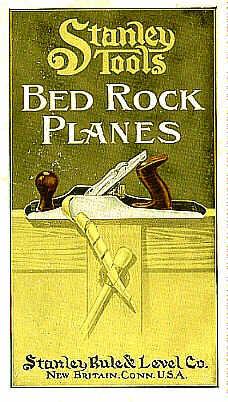 In a world where good
enough usually ain't good enough, Stanley decided to produce
another series of
metal bench planes, called Bed Rock planes. These planes
are, for all intents
and purposes, nothing but a variation of the more popular
Bailey series. They
all have an adjustable frog, the brass depth adjustment
knob, the lateral
lever, a lever cap, rosewood knob and tote, etc., just like
the Bailey's. The
key difference between the two designs is found in the way
the frog mates with
the bottom casting. For such a seemingly minor difference,
the Bed Rock planes
were offered at a premium over the Bailey's, and it was a
design that never
seemed to be very static nor nearly as popular as Stanley's
wildly successful
Bailey line.
In a world where good
enough usually ain't good enough, Stanley decided to produce
another series of
metal bench planes, called Bed Rock planes. These planes
are, for all intents
and purposes, nothing but a variation of the more popular
Bailey series. They
all have an adjustable frog, the brass depth adjustment
knob, the lateral
lever, a lever cap, rosewood knob and tote, etc., just like
the Bailey's. The
key difference between the two designs is found in the way
the frog mates with
the bottom casting. For such a seemingly minor difference,
the Bed Rock planes
were offered at a premium over the Bailey's, and it was a
design that never
seemed to be very static nor nearly as popular as Stanley's
wildly successful
Bailey line.
Since the primary difference between the two models
is in their frog
designs, most of what follows is paid to that minutiae. If
you don't wanna be
stuck in the quagmire of frog design, best find something
else upon which to
ponder, like modern day uses of the amazing fiberboard
planes, the #193A, #194, etc.
The Bailey frog underwent several modifications in an
attempt to make it
seat better, and cheaper (each and every frog, and its
receiving part of the bottom
casting, had to be machined for a proper fit). By about
1900, the frog design
had pretty much evolved into the design that most of us
handtool
fundamentalists recognize - the angled bottom that mates to
the bottom casting
at two areas, one along the rear of the mouth and the other
at a raised
crossbar that spans the interior width of the bottom
casting. In other words,
the frog does not mate with the bottom casting over the
entire area of the
frog's bottom. So someone at Stanley, Justus Traut (the dude
who gave us the #45, et al),
sniffed out a marketing opportunity here. What if a plane
were offered that had
a frog design where its entire bottom mated with a
corresponding area in the
bottom casting? There's sure to be megabucks reaped with
this design. Or so
Stanley thought. The series was a dud when compared to the
numbers of Bailey
planes sold, and it did have its bright spots, but it,
like so many other
attempts to build a better mousetrap, also went belly-up
after some 40 years of
production.
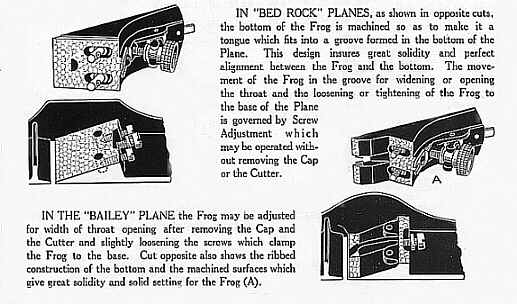 First,
the
basic frog design of the Bed Rock needs explanation. The
bottom casting has
a sloped and machined area onto which the frog seats, for
its entire length.
The frog itself only differs from the conventional Bailey
design in that its
bottom is flat and fully machined. A side view of the frog
yields a wedge-like
appearance. There is one other subtle detail about the frog
design - the frog's
bottom forms a broad and flat tongue, which fits into the
bottom casting's broad
and flat groove. This was provided to prevent the frog from
shifting side to
side, and guaranteed that the frog would move at a right
angle (to the mouth)
when the frog was adjusted. So there you have it, a frog
that mates with the
bottom casting over its (the frog's) full length and is
self-centering as well
(this design remained static during the entire production of
the Bed Rock
series). Sure woulda made me want to spend the extra 50
cents (average price
difference) to buy one of these babies back ca. 1900.
First,
the
basic frog design of the Bed Rock needs explanation. The
bottom casting has
a sloped and machined area onto which the frog seats, for
its entire length.
The frog itself only differs from the conventional Bailey
design in that its
bottom is flat and fully machined. A side view of the frog
yields a wedge-like
appearance. There is one other subtle detail about the frog
design - the frog's
bottom forms a broad and flat tongue, which fits into the
bottom casting's broad
and flat groove. This was provided to prevent the frog from
shifting side to
side, and guaranteed that the frog would move at a right
angle (to the mouth)
when the frog was adjusted. So there you have it, a frog
that mates with the
bottom casting over its (the frog's) full length and is
self-centering as well
(this design remained static during the entire production of
the Bed Rock
series). Sure woulda made me want to spend the extra 50
cents (average price
difference) to buy one of these babies back ca. 1900.
Someone else at Stanley, Edmund Schade, invented a
little gizmo that found
permanent use on all Bed Rocks and was latter added to the
Bailey line. It's a
lucky thing, too, that he did invent this otherwise it
probably would have been
impossible for Stanley to justify the Bed Rocks; i.e., it
may have been more
difficult to convince the tool-buying masses that the
difference between the
two lines was of any great significance. This little gizmo,
first offered on
the Bed Rock planes from their inception, is a little frog
adjustment screw
that engages a captive fork secured to the back of the frog.
This feature was
more of a gimmick than anything else, but it soon found
favor amongst hand
planers across America. By giving the screw a turn, the frog
moved either
forward or backward. Frog screwing, thought the stuff of the
plane lover's
fancy, soon swept America, and it was inevitable that this
mechanism would be
added to the Bailey design, which it was ca. 1910. It really
is a wonder how
planedudes survived without this feature for the previous
30/40 years, but they
did. The true merit of this feature was proved when, during
WWII, some of the
Bailey planes were offered without this. Think Stanley's
complaint department
had its phones ringing off the hook over this?
 The introduction of
the
frog adjusment screw to the Bailey series left the Bed Rocks
without any real
distinguishing pizazz, other than the bright red label used
on the boxes of the
planes, as the lever cap still had to be removed to gain
access to the screws
(that secured the frog to the main casting) in order to
adjust the frog in the
first place. To address this, the New Britain stinktank (tm)
had to come up
with some other gimmick to differentiate the Bed Rocks from
the Baileys, and
what they decided upon was the capability to adjust the frog
without removing
the lever cap and iron. Hey, think how much Joe Meatball's
daily existence was
bettered simply by saving him from having to remove the
lever cap, and then
backing off the two frog securing screws to adjust the frog,
something that's
done at least once or twice a month or two. But, guess what?
This swell feature
had already been solved a few years earlier by one of
Stanley's main
competitors, Sargent, located in New Haven, CT, just a short
trip south of New
Britain. On July 3, 1906, John Shaw received a patent for
frog adjustment
without having to remove the lever cap and iron assembly.
This innovation was
soon 'copied' by Edmund Schade, who came up with another way
to accomplish the
same function, on March 14, 1911. Stanley surely must have
perceived some
threat from Sargent over this, although the Sargent line of
planes
incorporating Shaw's patent aren't all that common. For a
detailed look at
Shaw's patent, click here.
The introduction of
the
frog adjusment screw to the Bailey series left the Bed Rocks
without any real
distinguishing pizazz, other than the bright red label used
on the boxes of the
planes, as the lever cap still had to be removed to gain
access to the screws
(that secured the frog to the main casting) in order to
adjust the frog in the
first place. To address this, the New Britain stinktank (tm)
had to come up
with some other gimmick to differentiate the Bed Rocks from
the Baileys, and
what they decided upon was the capability to adjust the frog
without removing
the lever cap and iron. Hey, think how much Joe Meatball's
daily existence was
bettered simply by saving him from having to remove the
lever cap, and then
backing off the two frog securing screws to adjust the frog,
something that's
done at least once or twice a month or two. But, guess what?
This swell feature
had already been solved a few years earlier by one of
Stanley's main
competitors, Sargent, located in New Haven, CT, just a short
trip south of New
Britain. On July 3, 1906, John Shaw received a patent for
frog adjustment
without having to remove the lever cap and iron assembly.
This innovation was
soon 'copied' by Edmund Schade, who came up with another way
to accomplish the
same function, on March 14, 1911. Stanley surely must have
perceived some
threat from Sargent over this, although the Sargent line of
planes
incorporating Shaw's patent aren't all that common. For a
detailed look at
Shaw's patent, click here.
Schade's novel way of frog adjusting was accomplished
by the addition of two
frog clamping screws that flank either side of the frog
adjusting screw. Each
of these screws is pointed (on the end without the slot) and
engages two pins
which have a corresponding conical depressions milled into
them. The pins fit
through the frog and into the bottom casting, and have no
holding power by
themselves. The two screws apply a downward force on the
pins when they are
tightened, thus locking the frog securely in position. By
backing off the
screws, the pressure on the pins is relieved, and the frog
can be moved forward
or backward by turning the frog adjustment screw. It's a
neat and efficient
frog adjusting mechanism, but its real merit is somewhat
questionable since
frog adjusting is not something done with any regularity,
like, say, adjusting
the plane's set (depth of cut). Click
here to see a
blow-by-blow description from the hands of
Stanley's propaganda machine.
And speaking of the plane's set, that's exactly what
changes whenever the
frog is adjusted forward or backward. Since the frog and its
mating surface are
inclined toward the mouth, the frog moves closer to or
farther from the mouth
as it's adjusted forward or backward respectively. With the
iron secured to the
frog, it follows, then, that the iron likewise moves closer
to or farther from
the mouth. Adjusting the frog forward increases the set, and
adjusting it
backward decreases the set. Now, granted, the amount by
which the set is
changed is small, but when using a smoother for finish work,
or using any bench
plane on a very hard wood, the slightest change in the set
needs to be
accounted for after the frog is adjusted, so there is really
no true reduction
in the number of adjustments to the plane as the frog is
repositioned. On the
plus side, however, you have another mechanism for adjusting
the iron's set
should you ever break the adjusting fork - who would have
guessed that Stanley
invented fault tolerant planing without their ever realizing
it?
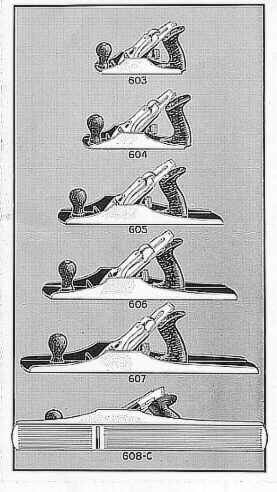 At the same
time the new frog securing screws were added, the bottom
casting itself
underwent a change in appearance. Where the casting rises up
around the frog,
on either side of the frog, the tops are lopped off flat,
instead of the normal
round sides found on the earlier Bed Rocks and the Baileys.
This change was
advertised as adding significantly to the strength and
stiffness of the plane
as well as affording an increased area when the plane is
used on its sides, a
claim that is rather dubious as Bed Rocks can be found with
cracks about the
main casting in this supposed strengthened area.
At the same
time the new frog securing screws were added, the bottom
casting itself
underwent a change in appearance. Where the casting rises up
around the frog,
on either side of the frog, the tops are lopped off flat,
instead of the normal
round sides found on the earlier Bed Rocks and the Baileys.
This change was
advertised as adding significantly to the strength and
stiffness of the plane
as well as affording an increased area when the plane is
used on its sides, a
claim that is rather dubious as Bed Rocks can be found with
cracks about the
main casting in this supposed strengthened area.
WWII spelled the end for these planes, as it did for
many other tools that
Stanley had offered for years. Most of these tools were on
life support anyway,
and the war was the final nail in the coffin, the Bed Rocks
included.
Other than the stuff I list above, there are some
other telltale ways to
date your Bed Rocks. Chief among the other ways is the lever
cap and its
embossing. The earliest models have "STANLEY/R. & L.
Co./BED ROCK" cast in
three separate lines (that's what the
/ means). Starting around 1910, the lever caps have "STANLEY/BED
ROCK" in two lines. A
few years
later, just "BED ROCK"
is cast. From ca. 1925 onward, "STANLEY" is all that appears. There
are other
differences in the models, but they are minor in the grand
scheme of things
here.
What follows is the actual Bed Rock models. These
parallel the Bailey planes
in function. As with those planes, the "C" designation means
that the
plane has corrugations in the sole (for reducing friction as
the plane forms a
vacuum with the wood); the "C" doesn't appear on the plane.
These
planes can suffer the same general damage that the Baileys
can, and for a
description of that damage, refer to the #3 of the Bailey series. The Bed
Rocks can also show
damage about the frog clamping screws - sometimes you can
find them with their
slots broken in which case you'll need to find
replacements.
Only three of the planes in the series are considered
anywhere near scarce,
the #602, #602C, and the #605 1/4. However,
there is a premium paid to acquire any of the planes when
buying from dealers.
This, in the author's opinion, is due to the hype found
within some books and
articles. If you want a better plane, and one that's less
costly, go with the
Type 2 Bailey's. These are the best planes what Stanley
ever did make.
#601
Smooth plane, 5
3/4L, 1 1/4"W, 1 1/4lbs, 2000-?.
Stanley never made one, but The Superior Works is. You can buy one yourself by
clicking here.
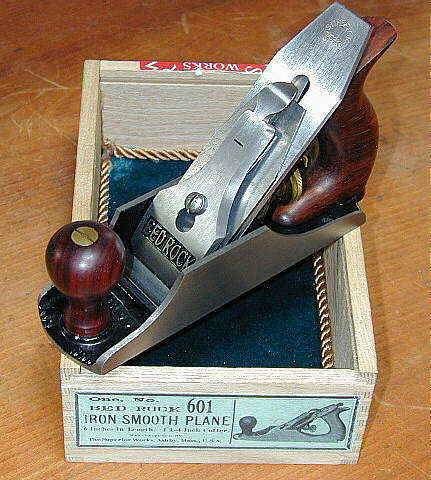
#602 Smooth plane, 7"L, 1 5/8"W, 2 1/4lbs, 1898-1942. *
There's a lot of stuff going on below the frog of the later Bed Rocks, and it's very apparent on this, the smallest planes of the series, when you try to jam a screwdriver down there to screw around with the frog. Still, they are popular planes with collectors and users of today, probably owing that to their unique look where everything is scaled down to make the plane look rather cute.
#602C Smooth plane, 7"L, 1 5/8"W, 2 1/4lbs, 1898-1918. *
Be careful for counterfeit corrugations on this one. It's one of Stanley's scarcer planes, especially in the round top configuration, which opens it up for the crafty tool artisans to apply their handiwork.
#603 Smooth plane, 8"L, 1 3/4"W, 3 1/4lbs, 1898-1943.
#603C Smooth plane, 8"L, 1 3/4"W, 3 1/4lbs, 1898-1935.
#604 Smooth plane, 9"L, 2"W, 3 5/8lbs, 1898-1943.
#604C Smooth plane, 9"L, 2"W, 3 5/8lbs, 1898-1935.
#604 1/2 Smooth plane, 10"L, 2 3/8"W, 4 3/4lbs. 1898-1935.
While many users fancy this plane as a fine worker due to its heft, they aren't especially enamoured with the price tag that usually accompanies the tool. If it's heft you want, and you have the money to buy this guy, save your lunch money for a few months more, and buy a real killer smoothing plane, an English infill. You'll never regret it as they far out-perform any Bed Rock plane.
#604 1/2C 10"L, 2 3/8"W, 4 3/4lbs, 1898-1935.
#605 Jack plane, 14"L, 2"W, 4 1/2lbs, 1898-1942.
Probably the most commonly encountered size of the Bed Rock series.
#605C Jack plane, 14"L, 2"W, 4 1/2lbs, 1898-1935.
#605 1/4 Jack plane, 11 1/2"L, 1 3/4"W, 4lbs, 1925-1943. *
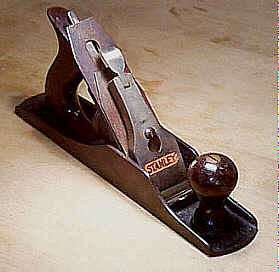 This plane is one of the
scarcest of the entire Bed Rock series.
This plane is one of the
scarcest of the entire Bed Rock series.
Note that this model can't be found with the earlier
round sides as it
wasn't introduced until after the series underwent the
design change of the
flat top side and the frog clamping screws.
Because the #605 1/4 is the Bed Rock
equivalent of the Bailey #5 1/4, which was a plane favored by
the trade schools for
manual training, and because the Bed Rock planes, plane
for plane, were sold at
a premium price over the Bailey equivalents, it follows
that these planes
didn't sell well to the trade schools, thus accounting for
their scarcity.
However, the planes were bought by some school districts,
and it's possible (or
was possible) to find stashes of these planes in schools.
Stanley never offered a corrugated version of this
plane in their catalogs.
This doesn't mean that they wouldn't possibly make one upon
special request, as
Stanley did for other stuff, but if you ever see one, I'd be
damn sure it was
legit before I plopped down more than $100 for it.
As an aside, I once bought over 200 of these from a
fellow who found a pile of them in Milwaukee. That city was
closing its trade schools, and a hoarde, rivaling the
Staffordshire Anglo-Saxon hoarde, was found. And, I didn't
even buy them all, as the guy sold many to other guys!
#605 1/2 Jack plane, 15"L, 2 1/4"W, 6
1/2lbs,
1898-1935.
Pay attention to this, and the corrugated version's, iron. It's non-standard with the others in the series, and if you're in need of a replacement, you'll have to snag it from a similar vintage #5 1/2 or a #27 1/2.
#605 1/2C Jack plane, 15"L, 2 1/4"W, 6 1/2lbs, 1898-1935.
#606 Fore plane, 18"L, 2 3/8"W, 7 3/8lbs, 1898-1941.
The nearest Stanley got to designating a single plane with the sign of the beast, 666. Push one of these suckers backward over some oak and you'll hear Ozzy Osborne chanting "norm is god, norm is god, all hail norm, prince of darkness and everything that's wrong with the world!"
#606C Fore plane, 18"L, 2 3/8"W, 7 3/8lbs, 1898-1934.
Push this one backward, and you'll hear Slim Whitman caterwaul "Shake Your Groove Thing." Yeah, yeah.....
#607 Jointer, 22"L, 2 3/8"W, 8 3/4lbs, 1898-1943.
#607C Jointer, 22"L, 2 3/8"W, 8 3/4lbs, 1898-1935.
#608 Jointer, 24"L, 2 5/8"W, 9 3/4lbs, 1898-1940.
#608C Jointer, 24"L, 2 5/8"W, 9 3/4lbs, 1898-1935.
[ START ] |
[ PREV ] | [ NEXT ] | [
END ]
[ HOME
]
Copyright
(c) 1998-2012 by Patrick A. Leach. All Rights Reserved.
No part may be
reproduced by any means without the express written
permission of the author.